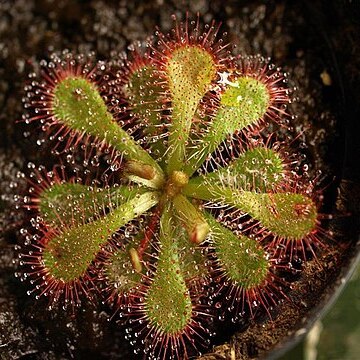Perennial herb, 0.01-0.25 m, acaulescent. Leaves in a compact, basal rosette; sessile; blade with terete tentacles, tipped with knob-shaped glands and tapered tentacles with flattened glands. Flowers: stipules laciniate, auriculate. Flowers: in an inflorescence 100-200 mm long; petals pink, mauve, violet or white; Dec.-Apr. Fruit oblong, 5 mm long.
Leaves in basal rosettes; lamina 0·3–1·5 x 0·2–0·7 cm., obovate-spathulate, glandular; stipules 2–3 mm. long, connate at the base, apex lacerated; petioles 0·3–3·5 cm. long, broadening into the lamina, glabrous or sparsely pilose.
Small, hairy herb with compact, basal rosettes. Stipules laciniate, auriculate. Inflorescence 100-200 mm long. Style arms entire, spoon-shaped. Seed ovoid. Flowers pink, mauve, violet or white.
Peduncles 1–2(6), 2–17 cm. long, arising laterally from the rosette then curving to become erect, canaliculate, glabrous or sparsely pilose in the lower part, glandular in the upper part.
Sepals 5, 3–6 x 2–2·5 mm., connate at the base, ± elliptic, obtuse, slightly irregularly serrulate at the apex, glandular.
Inflorescence racemose, 3–12-flowered; pedicels 1–5 mm. long, glandular; bracts 1–3 mm. long, linear-elliptic, caducous.
Ovary subglobose, glabrous; styles 3, 2 mm. long, 2-partite to the base with spathulate apices.
Seeds 0·3–0·6 x 0·2 mm., black, ovoid; testa usually foveolate.
Petals 5, 7–8 mm. long, pink or crimson to reddish-purple.
Stamens 5, filaments 5 mm. long.
Perennial herb, acaulescent.


